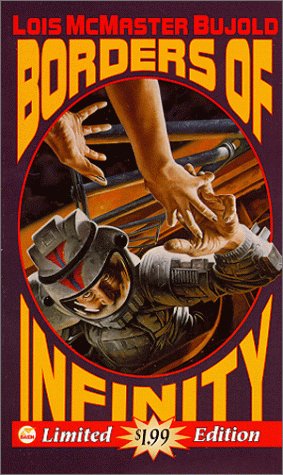The Borders of Infinity is a collection of short stories about Miles. One of them, “The Mountains of Mourning,” is about Miles Vorkosigan on Barrayar, and the other two are about Admiral Naismith, galactic mercenary (daring rescues a specialty).
Brothers in Arms and the collection The Borders of Infinity were both published in 1989. When I re-read the way I normally do, chronologically, I’m never sure which order to read them in, as the stories take place at such different times, the frame story is clearly after Brothers in Arms and yet Brothers in Arms opens with Miles surveying the damage from The Borders of Infinity. (It’s probably a good thing the collection doesn’t exist in that form any more except for hardback collectors so people who want everything chronological can have it in the new versions.)
But I’m reading in publication order, and they were both published in 1989. With the computer off, I couldn’t tell which had actually been published first. So I grabbed The Borders of Infinity on the grounds that at least some of the stories are earlier. Looking around, it seems I was wrong, sorry.
The frame story is set immediately after Brothers in Arms and does not develop the main internal chronological plot of the series at all. Miles is having the bones of his arms replaced with plastic bones, and ImpSec is being audited. It’s a very shallow frame, barely an outline to hang the three novellas from. It’s a fairly clunky device. Having said that, I kind of like it. It gives us a bit more Miles, a bit more Simon, and it actually does some set-up for Memory, though it probably could have done that better if it had known what it was doing. In losing the collection in favour of inserting the stories at the right chronological points, the frame is lost entirely, and I think I’d miss it.
The Mountains of Mourning is set immediately before The Vor Game, which of course she hadn’t written yet. It’s the best written thing in the series so far. Miles, fresh out of the Imperial Academy, goes up to the backwoods of the Dendarii mountains and discovers what he’s fighting for. It’s the most significant part of the whole sequence as far as understanding Miles goes, because Miles doesn’t work without his heart in Barrayar. Miles is interesting most especially because he’s pulled in many directions, and this one is what matters most. This is Miles’s emotional core. The story is quiet and understated and people mentioned in the Warrior’s Apprentice post that it’s online.
Labyrinth gives us a close up look at Jackson’s Whole and thus sets up Mirror Dance. It also introduces Taura, and has a quaddie, connecting back to Falling Free and forward to Diplomatic Immunity. It’s an interesting model of daring rescue, actually. Miles is sent in to kill a monster, when what’s necessary is to rescue a princess. He thinks this himself, and Taura’s transformation from monster to princess (or at least mercenary) is what the story is about. It all goes very smoothly.
The Borders of Infinity is clearly a thought experiment of Miles carrying on naked. I noticed that in Shards of Honor Cordelia thinks Aral could do it, and here Miles does it. It’s another daring rescue, he rescues thousands of prisoners of war from a prison camp after getting them organized using nothing more than willpower. This gets the Cetagandans really mad at him, which becomes important in Brothers in Arms. He also traumatises himself by losing a woman out of the shuttle, as if he needed to be any more traumatised.
Through all of these Miles continues convincingly manic depressive and to make his physical problems seem trivial. He sometimes manages to carry on through unconvincing amounts of pain, or at least sufficiently more pain than I could carry on through, and I’m fairly used to it myself. Having said that, she never really pushes it into total unbelievability—and here the frame story helps, by showing us Miles completely helpless.
In the context of the series, she wrote these three stories that are oh-so-definitely about Miles, and contextualising the whole universe around Miles, while at the same time writing the next Miles novel, so she must have definitely made some decisions about direction. It’s a good place to start the series, or at least a lot of people seem to have happily started it here and gone on to love it. It’s taking the series forward by focusing on Miles. I mentioned that the most interesting thing about Miles is his dual nature, the way his heart is on Barrayar and yet he can only really relax, and only really succeed, and only really serve when he’s being Admiral Naismith. The novels all play on that. These stories divide him up, one on Barrayar, two in space. The frame roots them to Barrayar.










